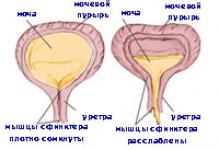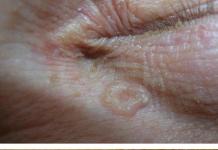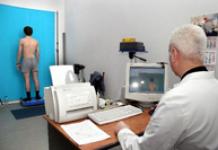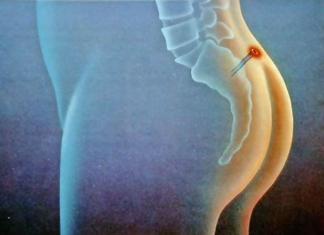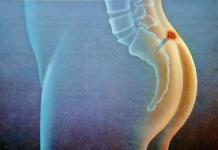For diseases thyroid gland Neck pain and suffocation may occur. The functional activity of the thyroid gland depends on the presence of iodine in the body. You will be able to feel it for yourself. You can feel something choking you and your neck tightening.
Why does there be a feeling of pressure in the throat?
During pathological processes, the size of the thyroid gland begins to increase, pressure appears in the throat, and you feel constant pain. Often this can be:
There are a lot of signs of thyroiditis. It all depends on the form of the disease. Thyroiditis occurs:
- acute purulent;
- acute non-purulent;
- chronic fibrous;
Diseases that cause discomfort
- Acute purulent thyroiditis develops during an acute or chronic infectious disease. It could be a sore throat, pneumonia, etc. Pain begins in the neck area in front, which radiates slightly to the back of the head and jaw. Are increasing The lymph nodes and increased head movements. Body temperature begins to rise.
- Subacute thyroiditis can appear after viral diseases such as mumps, acute respiratory viral infections, and coxsackie. Most often, carriers of this type of thyroiditis are women over 30 years of age. Pain also appears in the neck and ears, migraines, the patient’s activity increases and decreases, sweating and weight loss are observed. When the illness lasts for a long time, drowsiness, swelling on the face, dry skin, and a lethargic state appear.



- Chronic fibrous thyroiditis mainly affects people who have had or. The patient's thyroid gland becomes enlarged and thickened, and its functions are impaired.
- With autoimmune chronic thyroiditis, there are no symptoms in the first few years. Most often, this disease occurs in women over 40 years of age. When compression of the neck begins, the necessary levels in the blood decrease.
With hyperthyroidism, all processes in the body are accelerated due to the oversaturation of hormones in the blood. This causes frequent changes in mood, overexcitability, trembling hands, and disturbed sleep.
- Heart failure appears due to the large difference between the upper and lower. The vision begins to double, the eyelids swell. The eyes may become watery and there may be a stinging sensation. A person may lose vision.
- The digestive process is disrupted, appetite can either increase or decrease. The muscles begin to get tired quickly. Men may experience infertility, and women may experience infertility menstrual cycle. The patient begins to experience shortness of breath, and due to a decrease in lung capacity, metabolism accelerates.
- No matter how much the patient eats, the weight will drop sharply. Constant thirst appears and, as a result, polyuria (frequent urination). During such an illness, the skin, nails, and hair quickly wear out, and the person begins to turn gray early.
The symptoms of such a disease may not be detected in older people, since most of them are present as a pattern.
Oncological diseases of the thyroid gland
Typical tumors after chronic diseases. It can be:
- breast tumors;
- rectal diseases and colon cancer;
- diseases of the female genital organs;
- endocrine neoplasia.
When a patient develops a tumor, a nodule on one side of the neck may enlarge. At first, this nodule does not feel any pain. Over time, it begins to grow and thicken, and the lymph node enlarges.
In late stages of thyroid cancer, pain begins in the neck area, which is partially transmitted to the ear, pressure is felt in the thyroid gland, a feeling of suffocation and a lump in the throat, the voice becomes hoarse, the patient finds it difficult to breathe, and the veins swell. Such signs indicate that the tumor has begun to compress all the organs surrounding it.
There are several types of cancer:
- anaplastic.
During papillary cancer, tumors begin to emerge from many projections that resemble papillae. They respond well to treatment and are considered benign.

Medullary cancer is detected quite rarely. It can grow into muscle and trachea. Basically, the disease is transmitted through genes. Iodine therapy does not help treat the tumor. Only surgery will help get rid of it. The surgical method removes not only the thyroid gland, but also the lymph nodes.
Follicular cancer appears more often in older women. Cancer cells spread to the lungs and bones in the area of the diseased thyroid gland. The tumor can be cured with.

Anaplastic cancer is considered the rarest form of the disease. Cancer cells spread very quickly throughout the body. This type of tumor is practically incurable.
Any of these thyroid diseases can cause suffocation. To ascertain the cause, you need to consult a doctor. He will examine your throat, prescribe all the necessary diagnostics, medications to cure the disease, or send you for surgery. You should not self-medicate or delay it. This will worsen your condition, and treatment will be even longer and more difficult.
Thyroid cancer, itching all over the body, mushrooms | Doctor Myasnikov
The first symptoms of thyroid problems that should not be ignored
Thyroid gland: diagnosis and treatment of thyroid diseases in Medlife
Sometimes a person may experience such an alarming and extremely unpleasant symptom as a feeling of suffocation in the throat. The feeling that your “throat is choking” brings severe discomfort and can also be a symptom of some serious diseases. This problem should not be joked about: it requires a thorough examination, an accurate diagnosis, and appropriate treatment.
In the article we will consider what causes the feeling of suffocation in the throat area, and how to get rid of such an unpleasant sensation with medications and traditional methods.
What could it be?
When in fiction they describe a character's intense emotional distress and say that he has lost his breath and has a lump in his throat, this is not a metaphor. This feeling is a physiological response to stress. It is caused by uncoordinated work of the epiglottis and glottis in moments of crying, fear and confusion.
The illusion of a lump in the larynx or pharynx can persist for years if a person is emotionally “stuck” in his experience or experiences long-term depression. In this case, a psychiatrist or a visit to a psychologist, as well as a set of sedatives, will help.
In addition, experts say that the feeling of presence foreign body in the throat appears as a concomitant sign of various bodily diseases.
- Diseases of the ENT organs of a viral nature cause a burning sensation, scratching in the throat, and pain appears when swallowing. When treating ARVI, the symptoms disappear without a trace.
- The feeling of a lump in the throat occurs with Graves' disease, popularly called "goiter." Due to the excess secretion of hormones produced by the thyroid gland, this organ increases in size and puts pressure on the trachea, preventing the larynx from passing air and food. Therapy for thyrotoxicosis, which helps to reduce the thyroid gland, and control of the production of its hormones can help in this case.
- Disorders of the spine in the thoracic and cervical regions may be accompanied by a feeling of tightness in the throat and shortness of breath. Osteochondrosis develops as a result of compaction of intervertebral cartilage-discs and causes pain due to pinched nerve roots. The muscles of the pharynx tense, and a feeling of a lump appears in the throat. The solution to the problem is decompression of the spinal discs.
- Reflux esophagitis - inflammation of the esophageal mucosa causes heartburn and a sensation of a hard body in the pharynx and larynx. Reflux is the reflux of acidic gastric juice into the esophagus, irritating the walls of the esophageal tube. If this happens constantly, inflammation develops. The disease must be treated, because a non-healing injury to the mucous membrane of an organ can degenerate into a cancerous tumor. Therapy consists of reducing the degree of reflux and neutralizing the acidic environment. It is recommended not to consume foods that relax the esophageal sphincter (coffee, mint, chocolate), or to constantly take inhibitor drugs that reduce the acidity of gastric juice.
Factors that cause concern in the throat area may be allergic reactions of the body, inflammation of the epiglottis and other reasons, which a doctor will help to identify.
Symptoms
As a rule, at the same time as the unpleasant sensation, the throat begins to hurt and sore. It becomes difficult to breathe, and shortness of breath may occur. Solid foods are more difficult to swallow due to decreased passage of the esophagus, and indigestion, nausea and vomiting may also occur. Sometimes the pain is so severe that you want to “rip” the lump out of your throat.
Depending on the cause, pain is felt in the heart and chest, which can spread to the lower back. Fever, sweating, chills and increased body temperature are periodically noted. Weakness may appear in the legs and arms. Speaking is usually also harder.
What do you need to pay attention to to understand that a lump in your throat is cancer?
Modern experts rarely use the term “throat cancer”. A disease in which the epithelium develops malignancy, called laryngeal cancer.
A tumor can arise and continue to grow in different parts of the organ. This determines what symptoms accompany the disease.
- Metastases in the area of the upper, supraglottic parts of the larynx cause pain when swallowing, and it radiates to the ears. As the tumor grows, the feeling of something foreign in the throat increases.
- A neoplasm in the folded part of the larynx, where the vocal cords are located, leads first to hoarseness and then to complete loss of voice. The patient also has pain in swallowing and difficulty breathing.
- The growth of the tumor into the subglottic section of the larynx, connecting it to the trachea, significantly complicates breathing, a feeling of a lump in the throat is accompanied by coughing, and the release of saliva streaked with blood.
Signs of throat cancer may include general weakness, weight loss, deformation and dry skin in the neck area. In some cases, teeth hurt and fall out. There is a stable putrid smell from mouth.
Additional symptoms
In some cases, there may be additional symptoms of neck pain, which manifests itself as:
- tingling;
- numbness;
- swelling;
- pulsations;
- difficulty swallowing;
- dizziness;
- whistling in the head;
- swelling of the lymph nodes.
Sharp pain in the neck when intervertebral hernias or protrusions is often combined with headache, numbness in the hand or tingling in the hands. Pressure on nerve endings can cause very severe headaches in the back of the head. When the cervical vertebrae are affected, pressure surges and dizziness are typical.
What tests need to be taken?
In addition to conducting a physical examination, the doctor will prescribe tests that will provide a more accurate clinical picture. This is common and biochemical tests blood and testing it for tumor markers.
Malignant tumor cells produce special protein compounds that differ from the substances produced by healthy cells. They are identified by analysis of tumor markers. A large number of tumor markers in the blood indicates the presence of cancer in organism.
Other techniques
In most cases, neck pain can be relieved with conservative treatment. However, before starting therapy, it is very important to determine the underlying cause of their occurrence. It is important not only to eliminate unpleasant symptoms, but also to cure the underlying disease that triggered the attack of pain.

When choosing a therapy technique, it is important to consider possible complications for the patient. Treatment necessarily includes maintaining a rest regime, avoiding hypothermia and stress, and proper organization of physical activity.
After injuries and operations on the neck, the doctor may prescribe wearing a cervical collar. The course of application should be 1-4 weeks. It is important to choose the right size, as some deterioration in well-being may occur.
Physiotherapeutic techniques, in particular the use of ultrasound therapy, have a good effect. This will eliminate muscle spasms, reduce pain and inflammation. Low level laser exposure is also shown. During the period of remission, massage is indicated in combination with physical therapy. The operation is performed only in the most difficult cases.
What examinations should you undergo?
In addition to tests, the doctor will insist on mandatory examinations if cancer is suspected:
- Laryngoscopy - examination of the space and walls of the larynx for tumors. Today, a biopsy is performed using direct laryngoscopy (called fibrolaryngoscopy).
- Biopsy - collection of cells from the mucous tissue of the larynx for laboratory research. This method is considered the most reliable, since tissue samples are subjected to detailed microscopic, biochemical, and molecular genetic study.
- X-ray of the larynx and chest- a method that helps to see tumors in the pharyngeal cavity and the extent of their spread.
- Ultrasound is another imaging method that allows you to diagnose the presence of metastases in the larynx. Only wounds in the neck area can be a contraindication to it, since they can distort the diagnostic picture.
- Computed tomography is a method that uses x-rays and provides a three-dimensional image of the organs being examined. When diagnosing throat cancer, CT provides particularly valuable material, since it detects in detail the most minor changes in the condition of tissues.
Timely detection of tumor formations can prevent the development of a terrible disease, and vice versa, indifference to the symptoms will make the pathology irreversible! Cancer cells will begin to divide rapidly, the tumor will grow and grow into the tissue of nearby organs, and this will lead to excruciating pain and death.
Are you unsure of the correctness of the diagnosis and treatment prescribed for you? A video consultation with a world-class specialist will help dispel your doubts. This is a real opportunity to benefit from qualified assistance from the best of the best and not overpay for anything.
Pain on the right
Neck pain with right side can be observed with injuries, incorrect body position during sleep, or various diseases. The main reason for this is osteochondrosis, but you should not diagnose yourself and begin self-medication. Among others, the most probable causes you need to highlight the following:
- spinal canal stenosis;
- retropharyngeal abscess;
- lymphadenitis;
- arthritis;
- torticollis.
If pain is observed when turning the neck, then you need to visit a doctor to exclude or confirm the presence of severe neurological pathology. It is progressive in nature, therefore, gradually the patient’s health may deteriorate significantly. To clarify the diagnosis, you must undergo an examination by a neurologist.
What consequences can happen if you don’t see a doctor in time?
Oncologists say that in the first and second stages, cancer can be cured in 95% of cases. But, unfortunately, in the initial stages, cancer is almost asymptomatic. That’s why if you have the slightest discomfort in your throat, you shouldn’t delay visiting a doctor! It’s even better to visit him periodically for preventive purposes.
The procedure for suspected cancer should be as follows:
- contact your local physician for a referral to a specialist;
- visit an oncologist at your local clinic;
- get tested and undergo all mandatory examinations;
- do not despair if the diagnosis of cancer is confirmed - undergo a course of treatment and rehabilitation.
Causes of pain in children
If the pain radiates to the neck of a child, this may be due to a cold, mumps, rubella, meningitis, as well as some infectious diseases. If pain is observed only on one side, then the cause may be a retropharyngeal abscess, trauma, otitis, or lymphadenitis.
It is worth noting that pain when turning the neck can occur periodically in a child due to the presence of torticollis. Due to the presence of a defect, the baby takes a forced position. His neck is constantly turned in the opposite side from a defect. Pain occurs due to constant muscle strain.
Initially, you need to contact a pediatrician, who, after consultation, will refer you to a specialist.
Treatment depending on the situation
Scientists are working tirelessly to find a cure for cancer, but so far, alas, it is absolutely reliable and effective means No. When a disease is detected, official medicine always treats it in 2 ways - surgery and radiation therapy.
Methods, if the patient’s condition allows, are combined: first, the tumor is irradiated, and then it is removed. In some cases, patients are prescribed chemotherapy. Its meaning is to destroy tumors by taking medications. Chemotherapy is also indicated before surgery: the drugs make the tumor more compact and easier to remove.
There has been some success in treating cancer alternative medicine, which is not limited to traditional methods, but uses scientific, but not generally accepted, methods of treating an “incurable” disease. These, for example, include the semicarbazide-cadmium technology of the Kachugin doctors.
Drug therapy
The main drugs for eliminating painful sensations are anti-inflammatory drugs. It is worth noting that the main advantage of their use, in addition to the analgesic effect, is that they have an anti-inflammatory effect. In the acute phase of the disease medicines are prescribed in the form of injections, and then switch to taking tablets. Among the most popular drugs are the following:
- "Nimesulide".
- "Ibuprofen."
- "Diclofenac".
- Meloxicam.
In some cases, the use of anti-inflammatory drugs is not enough, therefore, glucocorticosteroids are often additionally prescribed, in particular, such as Cortisol. If the pain was caused by a muscle spasm, then taking muscle relaxants is required, as they help relax the muscles, resulting in normalization of blood circulation in the tissues and their nutrition. The most common drugs are Mydocalm and Sirdalut.

If neck pain is accompanied by hearing loss or dizziness, then taking medications to normalize blood circulation is indicated. Drugs such as Trental, Cavinton, and Eufillin may be prescribed.
Chondroprotectors are prescribed when neck pain is associated with various types of degenerative processes of the spine. They prevent the destruction of cartilage tissue and partially restore the affected vertebrae.
Forecast and what to expect?
There are several factors that help describe the scenario for the development of the disease and life expectancy for laryngeal cancer:
- The degree of resistance of the body to “occupation” by foreign cells.
- Patient's age: the younger the body, the faster the pathology develops.
- Location of the tumor and metastases in the throat: on the vocal cords the tumor grows slowly, and in the vestibule of the larynx the neoplasm develops quickly, spreading to the area of the lymph nodes.
Oncologists are confident that throat cancer can be prevented. Primary prevention of the disease is proper nutrition, elimination of carcinogens and strengthening the body's resistance.
It is important to seek the help of a specialist in time if there is a sore throat or a feeling of a lump in the throat. The next step is observation by an oncologist, therapy and treatment of cancer in the early stages, prevention of metastases and relapses.
Preventive actions
Basic rules on how to reduce the risk of asthma attacks:
- avoid severe stress;
- keep the house clean, regularly carry out wet cleaning;
- do not wear perfume or use strong-smelling chemicals for cleaning;
- avoid high physical activity, while regular light training is required;
- after suffering from viral diseases, it is necessary to take medications to increase immunity;
- Maintain normal air humidity in the room; it should not be too high.

As for other reasons that cause the condition of suffocation, it is necessary to consult with your doctor and individually select preventive (precautionary) methods.
Panic attack
It is a variant of vegetative-vascular dystonia. By its nature it is an anxiety-neurotic disorder.
It is most typical for representatives of the fairer sex due to the characteristics nervous system.
As statistics and specialized studies clearly show, every fifth person has experienced a panic attack at least once in their life.
Most often, anxious and suspicious individuals with a weak, labile type of nervous system suffer, and the symptom arises as a result of its overstrain.
Treatment is carried out with mild sedatives. In severe cases, you cannot do without antidepressants (Fluoxetine, also known as Prozac, works especially well).
Choking manifests itself reflexively. The patient feels short of breath, may faint, and experiences an intense feeling of fear and panic. Suicide attempts are possible during an attack, especially if it is the first.
Angina
It is also acute or chronic tonsillitis. The causes are always infectious. The main role in the development of pathology is played by decreased immunity.
Symptoms: sore throat, weakness, fever, excessive exudation, etc.
Upon visual examination, both or one tonsil is enlarged. It is their swelling that causes suffocation in the throat, since the lumen of the larynx narrows significantly.
The treatment is specific, anti-inflammatory and aimed at destroying bacteria or other pathogens.
Diphtheria
The disease is caused by Corynobacter. The infection is most often diagnosed in children. After infection, a fibrous film forms, which blocks the respiratory system, causing oxygen starvation. Swelling appears in the subcutaneous layer of the neck and enlargement of the lymph nodes is observed. When coughing, no sputum is produced.
Having identified what is causing the breathlessness and the feeling of suffocation, the doctor immediately begins treatment.
Delayed treatment may cause airway obstruction, which can be fatal. Therefore, before the ambulance arrives, parents should know how to relieve an attack as soon as possible and alleviate the patient’s condition.
Laryngospasm
It is a sharp involuntary contraction of the muscles of the larynx. The degree of spasm ranges from a slight feeling of lack of air to suffocation. A severe form of the symptom is accompanied by complete closure of the glottis and is a life-threatening condition. Due to anatomical features, such throat spasms more often occur in a child under 3 years of age than in an adult.

Causes:
- Rapid progression of an ENT disease, such as laryngitis.
- Contact with allergens or inhalation of irritants.
- Severe deficiency of calcium and vitamin D (children suffering from rickets are at risk).
Manifestations:
- difficulty breathing, accompanied by noise and whistling;
- tendency to quickly transition to a state of suffocation;
- hoarseness of voice.
The classic clinical picture of laryngospasm in children is brighter than in adults: spasms in the throat also cause a barking, whistling cough.
Hyperventilation
It is a neurocirculatory dystonia. It is one of its forms.
The essence of the pathological process lies in artificial neurotic control of breathing, during which the respiratory rhythm is disrupted and the patient begins to suffocate, experiencing suffocation and shortness of breath.
Excessive oxygen leads to abnormal blood counts. Migraines, dizziness, character changes begin heart rate.
The condition is corrected with mild sedatives and psychotherapy.
Endocrine pathologies
The feeling of squeezing of the throat and lack of air is sometimes caused by pathology of the thyroid gland. This is due to the pathological growth of organ tissue - goiter. The throat is subject to compression in moderate to severe cases of the disease. Then the pain may join.
Severe muscle spasms in the throat are also caused by damage to the parathyroid gland. A decrease in the level of parathyroid hormone leads to a pronounced lack of calcium and an excess of phosphates in the blood. Such an imbalance in the body is the cause of painful cramps. The pain affects almost all muscle groups, including the esophagus.
Chronic obstructive pulmonary disease
COPD is a common cause of a feeling of choking in the throat. The essence of the pathological process is the development of intense obstruction of the alveoli and bronchial tree.

Reasons for the formation of the disease:
- Smoking. It has a negative effect on the lungs and bronchi.
- Work at cement plants, chemical industrial facilities.
- Genetic predisposition.
Prematurity in childhood, active and passive smoking, and dietary levels low in vitamins play a major role in the development of the problem.
Characteristic symptoms:
- Destruction of the lung parenchyma, as seen on x-rays and tomography.
- Separation of a large amount of sputum during the cough reflex.
- Promotion blood pressure(hypertension).
- The formation of the so-called pulmonary heart(enlargement of its right parts, as a result of lung pathology).
- Hyperventilation syndrome.
- Intense cough.
- Shortness of breath and suffocation.
There is no specific treatment. Treatment is with corticosteroids and bronchodilators.
Heart attack
Defined as ischemic damage to the heart muscle. As a result of disruption of local blood circulation in the myocardium, destruction of surrounding tissue occurs, as a result of which the heart ceases to adequately pump blood throughout the body.
The condition is fraught with death. Death especially often occurs as a result of a large heart attack.
The reasons for the development of the condition are multiple. We are almost always talking about uncompensated hypertension and severe concomitant cardiac diseases.
The symptoms are atypical: pain develops behind the sternum of a dull pressing nature, shortness of breath, severe suffocation (as practice shows, it is localized precisely in the throat).
Therefore, if breathing problems occur, this may be a pre-infarction condition.
The patient feels a change in heart rhythm such as tachycardia (pulse more than 90 beats per minute). We can also talk about bradycardia (less than 60 beats per minute).
Treatment is carried out strictly in a hospital setting. Specialized medications are used to correct the condition, including anticoagulants, angioprotectors, and others.
Allergy
Allergic reactions are among the leaders in the number of cases of sudden suffocation. The immune response may have different intensities. From a minor rash to bronchospasm and anaphylactic shock.
Each case needs to be examined separately.
The causes of allergies are varied. This includes ingestion of allergenic food, inhalation of pathogenic structures, dust, chemical compounds in the form of dyes, air fresheners, detergents and washing powders (most often these factors provoke the symptom in question).
Manifestations: intense suffocation, especially with angioedema and anaphylactic shock, also with an attack of allergic bronchial asthma, pain behind the sternum, feeling as if something is itching in the throat.
Choking is often accompanied by classic signs of an immune response, including itching and redness. skin, lacrimation, copious discharge of clear mucus from the nose.
Treatment: first-third generation antihistamines, non-steroidal anti-inflammatory drugs, corticosteroids, bronchodilators in the system.
Psychoneurology
A number of mental illnesses appear in the form of a feeling of suffocation, a lump in the throat. Patients' complaints, as a rule, are emotionally charged: they may indicate pain, a feeling of fear of death, the inability to swallow food and breathe. The slightest irritant can cause breakdown. The results of an objective examination indicate the absence of pronounced pathological changes in the body. Nervous spasm in a healthy throat occurs with neuroses and depression.
If on the sides, then there can be a huge number of reasons for this. In this case, it is impossible to engage in self-diagnosis, since some conditions may require immediate medical intervention.
Panic attack
Most often, this sensation appears during an attack. This is a non-life-threatening condition when the patient seems to be dying from lack of air, because for some reason his throat is constricted.
Other manifestations include:
- Lack of air.
- Anxiety.
- Uncertainty.
- Increased blood pressure.
- Increased heart rate.
- Feeling of a lump in the throat.
- Coldness of hands and feet.
- The appearance of a rhinestone due to the possibility of dying.
Panic attacks can develop several times a year, but they are not relieved by any medications. The only way out is to visit a psychotherapist.
Osteochondrosis
– one of the most common diseases in middle-aged and elderly people. This is a degenerative-dystrophic pathology that cannot be completely cured. At the same time, the cartilage layer between the vertebrae is significantly reduced, causing them to literally begin to rub against each other, and this causes severe pain.
Pain also develops when a nerve root is compressed or pinched. And if a nearby blood vessel is damaged, this can cause various brain disorders.
Treatment of osteochondrosis is long-term and complex. During an attack, it is carried out in a hospital. It is important to follow all the doctor’s prescriptions and recommendations, as well as start doing special therapeutic exercises.
Allergy
Why is there still pressure on the sides of the neck? The cause may also be an allergic reaction, or more precisely, Quincke's edema. This is a life-threatening condition in which swelling of the larynx develops, leaving the person unable to speak or breathe.
Edema can develop as a result of an allergy to literally any substance, but most often it is a medicine or food product. It is important to provide first aid in a timely manner and administer medications to the victim that will help relieve an allergy attack.
After providing assistance, you should definitely contact an allergist and find out what is the cause of the development of edema. Only by knowing this will it be possible to avoid repeated allergic reaction.
Esophageal hernia
A relatively rare disease in which there is a feeling of squeezing of the throat. The causes can be either congenital (rarely) or acquired (most often).
In addition to difficulty swallowing, the patient will complain of significant pain that appears suddenly, for no reason, or after physical activity. Other manifestations include:
- Hoarseness of voice.
- Feeling short of air.
- Heartburn.
- Regurgitation.
- Hiccups.
- Increased salivation at night.
Without treatment, a variety of complications can develop, including strangulated hernia, esophageal stenosis, bleeding, and reflex angina.
Inflammation
If there is pressure on the sides of the neck, then the cause is a variety of inflammatory diseases of the throat. Any inflammatory process here it is severe, with increased temperature, as well as difficulty swallowing.
Moreover, these are not only acute diseases, but also chronic pathologies with exacerbations. The most common diagnoses are laryngitis or pharyngitis, as well as purulent sore throats. Basically, such diagnoses are made in childhood. In adults, sore throats are not as common.
Treatment is carried out with antibiotics and the use of local antiseptics in the form of a rinse solution.
Tumors
 Compression can also be associated with the development of tumors, both malignant and benign. In a benign course, it may be sufficient to conservative treatment, and with a malignant process, only surgery helps.
Compression can also be associated with the development of tumors, both malignant and benign. In a benign course, it may be sufficient to conservative treatment, and with a malignant process, only surgery helps.
Often the patient's complaints are associated not only with squeezing the throat, but also with such phenomena as rapid fatigue of the ligaments when speaking, problems with swallowing, hoarseness, and breathing problems.
If one or more symptoms appear, you should immediately consult a doctor. Self-medication leads to neglect of the process, which will then cause various serious complications.
Which doctor should you contact if you start to feel pressure on the sides of your neck? You should definitely visit a therapist, who, if necessary, can refer you to other specialists - oncologist, traumatologist, infectious disease specialist, endocrinologist.
Pain, a feeling of squeezing and fullness, difficulty swallowing food are all symptoms that patients describe as “discomfort in the neck.” The causes of discomfort can be very different - from problems with the thyroid gland to diseases of the spine.
What is most often associated with neck discomfort?
- Diseases of the thyroid gland. The thyroid gland can cause discomfort if it is very enlarged, inflamed (thyroiditis) or has nodules (nodular goiter). Patients may complain of a lump in the throat, pain in the front of the neck, difficulty swallowing, and hoarseness. The diagnosis of these conditions is carried out by an endocrinologist.
- Gastroesophageal reflux disease. Involves the reflux of acidic stomach contents into the esophagus. The disease is accompanied by heartburn, a feeling of a lump in the throat, and in severe cases - difficulty swallowing, hoarseness and sore throat. To confirm the diagnosis, you must contact a gastroenterologist.
- Cervical osteochondrosis. This is a disease in which degenerative processes develop in the intervertebral discs of the cervical spine. In this case, the nerve fibers that control the functioning of the neck organs can be pinched. Patients experience neck discomfort, foreign body sensation, and sometimes sore throat. The condition gets worse if the destroyed disc bulges outward and forms a herniation. Treatment of both pathologies is carried out by a neurologist.
- Neurosis. Patients with neurosis may complain of a feeling of pressure in the neck, rapid heartbeat and a feeling of shortness of breath. Unpleasant symptoms occur mainly against the background of emotional outbursts. Contacting a neurologist or psychotherapist helps solve the problem.
Where to start testing if you have discomfort in the throat and neck?
If it is unclear what is causing the discomfort, it is recommended to begin the diagnosis by visiting a therapist. This specialist will conduct a general examination, prescribe basic tests and, based on their results, determine which specialized specialist should be contacted. To find out the cause of the problem, the patient may be prescribed:
- tests for thyroid hormones,
- radiography of the spine,
- alkaline test with antacids, etc.
At the Spectra clinic you can undergo a full examination in 1-2 days. Experienced specialists will select a set of necessary diagnostic procedures, advise on their results and recommend adequate treatment methods. To make an appointment, call or leave a request on the website.
The trachea experiences pressure from the grown goiter, which may cause a sensation of a foreign body in the throat area.
The brain sends nerve impulses to the body, including protective reflexes: a cough appears, a burning sensation in the respiratory tract, and the voice may disappear.
These symptoms most often signal morphological changes in the parenchyma of the gland, and sometimes also indicate functional insufficiency of the thyroid gland.
In some cases, lack of air can be caused by thyroid cancer, which is why it is so important to start treating shortness of breath on time.
How to make sure that the problem is in the thyroid gland?
First you need to figure out where exactly the thyroid gland is located.
To do this, place your palm on the front of your neck and swallow.
With your hand you can feel the movement of the thyroid cartilage in the throat; it is under it that the endocrine gland is located.
The thyroid gland on both sides, like a butterfly, clasps the cartilaginous respiratory tube - the trachea.
By palpating the neck, you can diagnose an enlargement of the soft tissue of the thyroid gland, which causes an attack of suffocation.
During palpation, you need to study the structure of the thyroid tissue: it should be homogeneous, evenly embossed, without compactions.
A lump (nodule) is not a disease, it is a symptom indicating the development of pathological processes in the body.
By palpation, large nodes are usually detected, and with the help of ultrasound, nodes that are still early stage development.
Alarming symptoms!
Problems with the thyroid gland lead to an imbalance in the entire body.
It is necessary to consult a doctor as soon as possible if asthma attacks occur against the background of the following symptoms:
- sudden changes in body weight, even when following a diet;
- the appearance of memory problems;
- lethargy;
- unstable emotional background;
- constant drowsiness;
- weakened immunity;
- frequent headaches;
- deterioration of skin, hair and nails;
- disruptions of the menstrual cycle in women.
The causes of imbalance in the functioning of the endocrine system are often associated with poor environment, unhealthy lifestyle and poor diet.
Therefore, in the presence of these unfavorable conditions, the only thing you need to do is to listen sensitively to your body.
Poor Breath Makes Survival Difficult
An attack of suffocation in the throat area is one of the symptoms that causes round-the-clock torment.
Feeling unwell may make it difficult to work, sleep, or eat.
And the most unpleasant thing is that in addition to a lump in the throat, other dangerous conditions can develop.
For example, a patient may be examined for hyperthyroidism, a disease in which increased production of hormones occurs.
Usually, its appearance is caused by severe stress, physical fatigue, or other situations when the body spends a lot of energy on its recovery.
The opposite disease, which is no less often accompanied by suffocation in the throat area, is hypothyroidism.
In this case, the patient has a lack of hormones.
The thyroid gland, trying to compensate for this deficiency, begins to grow, which leads to the appearance of a goiter in the throat, which causes the patient to feel suffocated.
If infectious processes develop in the thyroid gland, a person’s neck swells, as if something is beginning to choke him.
This may be a symptom of autoimmune thyroiditis.
In some cases, this type of thyroiditis is accompanied by rapid growth of the connective tissues of the body and leads to the inability to eat and breathe.
Worst possible pathology– thyroid cancer.
It's never too late to treat your thyroid
For appointment proper treatment the patient must undergo a series of examinations and diagnostics: ultrasound, blood tests.
To treat hyperthyroidism, medications are prescribed - thyreostatics, which reduce the production of hormones.
The goal of treatment is to prevent excessive production of thyroid hormones.
After therapy, most people note the restoration of normal heartbeat, a decrease in anxiety and relief from inhibition of movements.
To correct minor disorders of the endocrine system, iodine therapy is often prescribed.
In later stages of the disease, surgery may be necessary.
However, the patient must understand that if the thyroid gland is removed, the usual way of life will have to be radically changed.
You will need to regularly replenish the body with artificial hormones, constantly monitor the level of hormones in the blood and adhere to a strict diet.
In addition, patients who have undergone such an operation are strictly prohibited from certain types of physical activity.
A special diet is an element of treatment
The products are a natural source of vitamins and microelements. A properly balanced diet will have the most beneficial effect on the body and will not allow the thyroid gland to choke it.
If you have iodine deficiency, endocrinologists recommend including in your diet:
What to do if there is a feeling of tightness in the neck?
VSD is a modern disease, but humanity is familiar with every symptom. People realized from their own experience that psychological problems often manifest themselves somatically. For example, the expression “I am choked by fear” is not a figment of fantasy, but a real syndrome. But people with VSD during a period of deterioration in health do not care about phraseology; it is important for them to quickly make sure that the feeling of tightness in the neck is not a sign of a terrible illness. And, of course, it is no less important to remove this unpleasant symptom.
Throat and VSD
The peculiarity of psychogenic illnesses is that they are completely unrelated to internal organs, however, they mercilessly hit them, forcing a person to attribute non-existent diagnoses to himself. So, a distinct feeling of pressure appears on the neck of the VSD person. It may resemble a tight collar or throat congestion, as with laryngitis. But often the patient is not able to describe to the doctor exactly how his neck is being compressed. Just like imaginary heart patients cannot tell how their heart hurts. But definitely, against the background of his “suffocation”, the patient may experience additional symptoms:
The listed symptoms suggest that the cause of the disease is in the nerves. Another important difference between a psychogenic illness and an organic one: a “nervous” throat cannot be constantly squeezed. As a rule, after waking up for several minutes (or even hours), the patient does not even remember his feeling of suffocation. But as soon as the brain activates the body and recalls yesterday’s sensations in memory, the symptom returns to its place. This suggests that the illness was recorded in the subconscious of the VSD person as a frightening, threatening situation, and acquired an obsessive form - like many other psychogenic symptoms.
Causes of imaginary suffocation
The feeling of tightness in the neck area has its own clear pattern of appearance and subsequent consolidation.
- The first fear of suffocation appears during a strong panic attack, usually in adolescence. At this time, VSD students are still too young and know nothing about dystonia. Lack of weapons in the face of a terrible symptom is forever fixed in the subconscious and forces the patient to expect the same suffocation during the next PA. Sometimes this fear is so strong that the VSD person, feeling the onset of a crisis, first feels his neck.
- With regular stress (virtually every dystonic person experiences it), the subconscious increasingly gives a breakthrough to the accumulated negativity and fear. Even if you just get nervous at work, your body immediately begins to exhaustively respond with somatic symptoms. As a rule, this is what the patient fears most. In our case, the neck. The brain is aimed specifically at her. The neck muscles tense and stiffen, complemented by unusual sensations given by the nervous system: the patient has a feeling of a lump in the throat, or pressure on the neck on the sides, behind, in the area of the Adam's apple or jugular cavity.
- The more a person fixates on these sensations, the more often and more vividly they manifest themselves. Fear sometimes results in real neurosis of the throat. The feeling of pressure on the neck begins to interfere with the patient’s daily life. It seems that any scarf, glass of hot tea or awkward movement of the head can increase the tightness. The feeling of helplessness in the face of an obsessive symptom can lead to depression.
Effective ways to solve the problem:
- Realize: your life is not in danger, and all unpleasant sensations are a false pathology. Calmness and self-confidence are necessary conditions for a good start in the fight against the disease. If you are still concerned, visit a therapist, ENT specialist and neurologist - studies will convince you that there is actually nothing wrong with your throat. An exception may be cervical osteochondrosis, which actually gives various strange sensations in the neck due to compressed vertebral roots.
- Switch yourself intensively to another “illness”. As soon as you feel pressure on your neck again, fixate on another part of your body. VSDers often turn their attention to their cold fingers, simultaneously killing two birds with one stone. If you intensely imagine that pleasant warmth is flowing to your fingers, you can really make the blood vessels relax and the body warm up.
- Find an activity that won't touch your neck while doing it. It can be something urgent or complex, or something very exciting. It’s good if you find a new (or well-forgotten old) hobby, the thoughts of which will take you away from your nervous neck, and at the same time from many other symptoms of dystonia.
- See a therapist. After all, the root of your problems may not be limited to just fear during PA. It is quite possible that the fear of suffocation appeared in your distant childhood, and you don’t remember anything about it. During psychotherapeutic sessions, all the packages with surprises are surprisingly opened, and then the person successfully gets out of his vicious circle.
- The feeling of tightness in the neck during VSD can only be a signal from your body that it needs a break. Or drastic changes in lifestyle and habits are required. Quitting smoking and alcohol, improving sleep and diet, daily walks... All this seems banal only because you did not follow this advice.
And you, as a person who wants to recover, will definitely try all the options.
Unpleasant sensations in the neck area: possible causes of their occurrence
Our body is structured as a single whole, it is a huge and complex mechanism, and if suddenly some part of this system fails, then the violation affects everything. Therefore, slight tension in the neck may already indicate serious problems in the functioning of the body. The reason why there is pressure in the throat can sometimes be a consequence of curvature or damage to the cervical spine. Only a doctor can clearly explain this relationship.
Common Causes of Neck Tension and Throat Pressure
Inflammatory processes, wherever their epicenter is (skull, jaw, throat), cause discomfort in the cervical region. There are also less serious causes similar sensations. For example, with prolonged stress on this muscle group or after a sudden movement. A common draft can also serve as a banal reason. If it’s painful, then any ointment will do and gently massage the neck area to get rid of pain and tension in it.
If the pain is localized on the sides of the throat, then this may be a rare inflammation carotid arteries(carotidynia). Aspirin will also help here, if it’s not too advanced.
If there is pressure in the neck, then this can say a lot. You can even make a list of the main possible reasons for this situation:
- Exposure to draft
- Infections
- Thyroiditis
- Muscle spasm
- Mechanical damage, injuries
- Arthritis
- Carotidynia
- Osteochodrosis
- Cancerous tumor - in rare cases
- Pinched nerve
Is it possible to avoid this?
In serious cases, if you are faced with this problem, then only treatment and strict adherence to the recommendations can help you.
Sometimes there is a lot of pressure on the neck, and this is no longer an unpleasant discomfort, but a little painful. But such tension in the neck is not constant, but happens periodically. Which doctor should I go to so as not to waste extra time on a therapist?
What to do if the thyroid gland is pressing on the throat
The thyroid gland plays a vital role in the body; it produces hormones that are responsible for the proper functioning of many organs and systems. Therefore, if its function is impaired, the entire body suffers and this entails serious health problems.
Quite often, problems with the thyroid gland are reflected by unpleasant sensations in the front of the neck, squeezing of the throat, and a feeling of suffocation. In our article we will try to talk about what to do if the thyroid gland is pressing on the throat, why this condition occurs, its main methods of treatment.
Causes of thyroid pressure on the throat
Since the thyroid gland is located in the front of the neck, the slightest increase in it causes pressure on the walls of the throat, a feeling of discomfort arises, the person feels that the throat is being pressed, and it becomes difficult to breathe. The main reasons that lead to this condition are:
- Inflammation of the thyroid gland (thyroiditis). There are several main types of the disease: Hashimoto's thyroiditis, purulent, non-purulent and Riedel's thyroiditis. Purulent often occurs against the background of infection. It enters the body and affects the gland, thereby causing its enlargement, pain in the neck, fever, etc. Non-purulent inflammation is associated with various injuries and damage to the thyroid gland. Hashimo's thyroiditis is an autoimmune disease, while Riedel's thyroiditis is classified as a fibrous disease, the cause of which is still not fully understood.
- Thyroid oncology. This is a serious pathology that requires timely diagnosis and proper treatment. In this case, the patient’s health condition deteriorates significantly, and strong pain in the area of the gland, over time the organ enlarges, the patient finds it difficult to breathe, and strong pressure arises in the throat, making it difficult to swallow.
- Hyperthyroidism (increased production of hormones). In addition to disruption gastrointestinal tract, of cardio-vascular system, nervous disorders, this pathology is characterized by an increase in the size of the thyroid gland, swelling in the neck. In this regard, patients complain that the throat is tight, it is difficult to breathe, shortness of breath occurs, and the voice changes.
- Benign formations. Benign tumors can also cause the above symptoms and often lead to a condition where there is a feeling of pressure in the throat.
What to do if the thyroid gland compresses the throat
Of course, all patients are interested in the question of what to do when the thyroid gland presses on the throat. The only correct decision in this case is to immediately contact a specialist.
As a rule, in this situation, the doctor conducts a thorough diagnosis and finds out the cause of this condition. The initial examination consists of a visual examination of the patient and palpation of the thyroid gland; the doctor may also prescribe additional diagnostics, most often an ultrasound examination of the organ, hormone tests, and, if necessary, a biopsy.
When the above-described condition occurs against the background of increased hormonal levels, the basis of treatment is hormone therapy, in which the patient is prescribed synthetic hormones.
To relieve the symptoms of thyroiditis, many patients are prescribed replacement therapy, which includes the use of thyroid hormones. In case of purulent form, antibiotics must be taken; in some cases, corticosteroids are indicated. This therapy may also include symptomatic remedies, taking vitamins, immunostimulating drugs, and alternative methods of treatment.
For malignant and some benign tumors, the main therapeutic method is surgery. Through surgery, a tumor or an entire organ is removed from patients. In the case of small benign formations that do not require surgical treatment, patients are recommended a special diet and regular examination by a doctor.
It should be remembered that the thyroid gland needs special attention; at the slightest suspicion of disturbances in its functioning, especially when there is a feeling that there is pressure in the neck, you should immediately undergo examination by an endocrinologist.
For what diseases and why does the thyroid gland suffocate?
Why does there be a feeling of pressure in the throat?
During pathological processes, the size of the thyroid gland begins to increase, pressure appears in the throat, and you feel constant discomfort. Often this can be:
- inflammation of the thyroid gland (thyroiditis);
- excess production of hormones (hyperthyroidism);
- thyroid cancer.
During pathological processes, the size of the thyroid gland begins to increase, pressure appears in the throat, and you feel constant discomfort.
There are a lot of signs of thyroiditis. It all depends on the form of the disease. Thyroiditis occurs:
- acute purulent;
- acute non-purulent;
- subacute;
- chronic fibrous;
- chronic autoimmune.
Diseases that cause discomfort
Acute purulent thyroiditis develops during an acute or chronic infectious disease. It could be a sore throat, pneumonia, etc. Pain begins in the neck area in front, which radiates slightly to the back of the head and jaw. Lymph nodes become enlarged and pain intensifies during swallowing and head movements. Body temperature begins to rise.
Subacute thyroiditis can appear after viral diseases such as mumps, acute respiratory viral infections, and coxsackie. Most often, carriers of this type of thyroiditis are women over 30 years of age. Pain also appears in the neck and ears, migraine, body temperature rises and the patient’s activity decreases, sweating and weight loss are observed. When the illness lasts for a long time, drowsiness, swelling on the face, dry skin, and a lethargic state appear.
Chronic fibrous thyroiditis mainly affects people who have had Graves' disease or endemic goiter. The patient's thyroid gland becomes enlarged and thickened, and its functions are impaired.
With autoimmune chronic thyroiditis, there are no symptoms in the first few years. Most often, this disease occurs in women over 40 years of age. With an enlarged thyroid gland, compression of the neck begins, and the necessary hormones in the blood decrease.
With hyperthyroidism, all processes in the body are accelerated due to the oversaturation of hormones in the blood. This causes frequent changes in mood, overexcitability, trembling hands, and disturbed sleep.
Heart failure occurs due to a large difference in upper and lower pressure. The vision begins to double, the eyelids swell. The eyes may become watery and there may be a stinging sensation. A person may lose vision.
The digestive process is disrupted, appetite can either increase or decrease. The muscles begin to get tired quickly. Men may experience infertility, and women may experience menstrual irregularities. The patient begins to experience shortness of breath, and due to a decrease in lung capacity, metabolism accelerates.
No matter how much the patient eats, the weight will drop sharply. Constant thirst appears and, as a result, polyuria (frequent urination). During such an illness, the skin, nails, and hair quickly wear out, and the person begins to turn gray early.
The symptoms of such a disease may not be detected in older people, since most of them are present as a pattern.
Oncological diseases of the thyroid gland
Thyroid cancer - malignant tumor, which affects the most important organ of the human endocrine system. This pathology is often found in girls. The tumor can appear at any age. Most often, this disease occurs in people who suffer from iodine deficiency. It may appear in a few years.
In old age, people experience malfunctions in their genes, resulting in the appearance of a tumor.
A tumor can arise from radiation exposure. The reason may be radioactive rain that began after a nuclear weapon test. Frequent X-ray exposure may cause tumors in the head and neck area.
In old age, people experience malfunctions in their genes, resulting in the appearance of a tumor. The reason may be harmful work in workshops related to metal, or bad heredity. But the easiest way to get thyroid cancer is through tobacco and alcohol.
Typical tumors after chronic diseases. It can be:
- breast tumors;
- rectal diseases and colon cancer;
- multinodular goiter;
- diseases of the female genital organs;
- endocrine neoplasia.
When a patient develops a tumor, a nodule on one side of the neck may enlarge. At first, this nodule does not feel any pain. Over time, it begins to grow and thicken, and the lymph node enlarges.
In late stages of thyroid cancer, pain begins in the neck area, which is partially transmitted to the ear, pressure is felt in the thyroid gland, a feeling of suffocation and a lump in the throat, the voice becomes hoarse, the patient finds it difficult to breathe, and the veins swell. Such signs indicate that the tumor has begun to compress all the organs surrounding it.
There are several types of cancer:
During papillary cancer, tumors begin to emerge from many projections that resemble papillae. They respond well to treatment and are considered benign
To ascertain the cause, you need to consult a doctor. He will examine your throat and prescribe all the necessary diagnostics.
Medullary cancer is detected quite rarely. It can grow into muscle and trachea. Basically, the disease is transmitted through genes. Iodine therapy does not help treat the tumor. Only surgery will help get rid of it. The surgical method removes not only the thyroid gland, but also the lymph nodes.
Follicular cancer appears more often in older women. Cancer cells spread to the lungs and bones in the area of the diseased thyroid gland. The tumor can be cured using iodine treatments.
Any of these thyroid diseases can cause suffocation. To ascertain the cause, you need to consult a doctor.
Anaplastic cancer is considered the rarest form of the disease. Cancer cells spread very quickly throughout the body. This type of tumor is practically incurable.
Any of these thyroid diseases can cause suffocation. To ascertain the cause, you need to consult a doctor. He will examine your throat, prescribe all the necessary diagnostics, medications to cure the disease, or send you for surgery. You should not self-medicate or delay it. This will worsen your condition, and treatment will be even longer and more difficult.
About the most important things: Thyroid cancer, itching all over the body, mushrooms
The first symptoms of thyroid problems that should not be ignored
Thyroid diseases - symptoms and consequences
Thyroid gland: diagnosis and treatment of thyroid diseases in Medlife
Feeling of constriction (choking) in the throat: causes and treatment
In medicine, there are many diseases of various natures that can lead to symptoms such as choking or a feeling of constriction in the throat.
The reason may lie either in a simple infectious pathology, which led to tissue swelling and narrowing of the lumen of the larynx, or in more serious diseases, such as malignant neoplasms.
Various patients often come to the doctor, united by one complaint - the appearance of suffocation. In this case, it is important to clearly assess all possible causes, find the main factor and begin influencing it. Careful diagnostic measures will help relieve the patient of an unpleasant symptom.
In this article we will talk about possible reasons the appearance of choking in the throat and what measures the patient needs to take to treat such a symptom.
Possible causes of tightness in the throat
There are a huge number of factors that can cause compression in the throat, an unpleasant feeling of suffocation for any person. The most common reasons are:
- acute infectious diseases;
- damage to the neck joints by arthritis;
- pinched nerves passing through the neck;
- various pathologies of the thyroid gland;
- traumatic injuries to the neck area;
- development of tumor pathologies;
- some diseases of the respiratory system, etc.
In some cases, stress on the body can lead to the appearance of a characteristic unpleasant symptom. If a symptom develops against the background of stress, there is no need to worry about the functionality of the organs: the feeling of compression will disappear as soon as the person calms down, having gotten rid of the stress factor.
In young children, a feeling of suffocation often develops due to various foreign objects entering the respiratory tract. In this case, the child additionally begins to cough, trying to free the windpipe. This situation is life-threatening, since a foreign structure that gets into the respiratory tract can completely block breathing, leading to suffocation and death. Getting rid of the symptom in this case is quite simple: it is necessary to provide assistance in clearing the airways.
Sometimes complaints of compression in the throat area are caused by the habit of wearing tight clothes that fit tightly to the throat area. In this case, the person is advised to refuse to wear such clothing. In most cases, the appearance of a symptom due to clothing only means that the person’s neck area is very sensitive, but this is not considered a pathology.
Additional symptoms
The feeling of suffocation rarely appears as a single symptom. In most cases, this complaint is accompanied by a wide range of additional signs of a disease, which helps the doctor in diagnosis.
Also, due to the small space of the neck, which contains a large number of vital organs, suffocation is often caused by several different pathologies developing simultaneously. A person may additionally complain of the following symptoms:
- the appearance of a feeling of discomfort during a conversation or such a feeling that appears if you have to talk for too long;
- a feeling as if a lump has formed in the throat, which interferes not only with the respiratory process, but also with the act of swallowing; it is not possible to get rid of the lump;
- painful sensations can also accompany the act of swallowing, which is especially common when inflammatory diseases mucous membrane;
- due to a lack of oxygen when the arteries are injured, complaints of heaviness in the back of the head and headaches may appear; in case of severe circulatory disorders, episodes of loss of consciousness are also possible;
- a feeling of numbness in the limbs, which can be either neurological in nature or develop due to insufficient blood circulation.
The presence of additional symptoms that the patient complains about, in most cases, helps the doctor narrow down the search for causes. The main thing is that during an appointment with a specialist, the patient talks as fully as possible about what exactly is bothering him.
For the treatment and prevention of runny nose, sore throat, ARVI and influenza in children and adults, Elena Malysheva recommends effective drug Immunity from Russian scientists. Thanks to its unique, and most importantly 100% natural composition, the drug is extremely effective in the treatment of sore throats, colds and strengthening immunity.
How do different diseases differ in diagnosis and treatment?
If a feeling of constriction appears in the throat, the doctor, when the patient seeks help, conducts differential diagnosis between various diseases. Based on the diagnostic results, the patient begins therapy, which should alleviate his condition and relieve unpleasant symptoms.
Depending on the type of pathology, treatment can be either conservative or surgical. It is important not to try to treat the feeling of suffocation on your own, since without an accurate diagnosis, at best, a person will simply waste time fighting the symptom rather than its cause, and in the worst case, it will provoke a worsening of his own condition.
Neurological pathologies
Neurological and mental pathologies of various spectrums often cause suffocation. This symptom often accompanies depressive states, hyperventilation syndrome, neurasthenia and various panic attacks.
Interestingly, due to the greater lability of the nervous system, such problems arise in women somewhat more often than in men. The severity of suffocation in the fair sex is also often more severe.
The feeling of suffocation in neurological disorders is often accompanied by additional symptoms such as an acute feeling of fear, palpitations and attacks of dizziness, and an acceleration of the heart rate. All these phenomena are a consequence of severe overstrain of the human nervous system.
Neurologists, psychotherapists and psychiatrists treat such pathologies. Patients are prescribed drugs that have a sedative effect (depending on the severity of the disease and its type, both simple decoctions of sedative herbs and more serious drugs) and medications from the spectrum of antidepressants can be prescribed.
Many drugs used to treat neurological pathologies are available only by prescription, so they cannot be obtained without consulting a doctor.
How to treat the feeling of shortness of breath
Neoplasms of various natures
Tumors of benign and malignant nature are another common reason the appearance of a feeling of constriction in the throat. This reason for the appearance of the symptom is completely mechanical in nature. The fact is that there is little space in the neck, which means it is very easy to cause compression of nearby structures.
The more the tumor grows, the more pronounced the symptoms of compression will be, which, in addition to suffocation, usually include a feeling of a lump in the throat, weakening or complete loss of voice, hoarseness, and difficulty swallowing.
The approach to treating a tumor disease will depend on its nature and growth rate. If a patient is diagnosed with a benign formation that does not grow at all and does not cause severe inconvenience, then he will be recommended to undergo regular monitoring by a specialist. Observations are necessary to monitor the development of the tumor and, if there is a danger of its degeneration, to remove it surgically.
If the tumor is malignant, it will most likely have to be removed surgically. After removal of the tumor, the person will be advised, depending on the stage of the process, radiation therapy or chemotherapy to prevent relapses. Drugs from the group of cytostatics may also be prescribed. The patient will also have to be observed for a long time by oncologists, whose task is to promptly detect new tumors and begin their treatment if necessary.
Depending on additional symptoms, the patient may be advised vitamin complexes, sedatives, painkillers of varying degrees of effect.
Swelling of the mucous membrane
Swelling affecting the mucous membrane is not considered an independent type of disease, but acts as an additional symptom. As in the case of tumors, the cause of suffocation is mechanical: swelling of the mucous membrane develops, which leads to a narrowing of the lumen of the larynx, which means less oxygen enters the body.
Swelling of the mucous membrane of the throat can occur due to injuries, after burn wounds, as a result of severe infectious diseases or allergic reactions. Depending on the cause of the swelling, treatment will be selected.
Very often laryngeal edema is accompanied by pain syndrome, which appears either in response to swallowing or during conversation. This occurs due to the fact that the mucous membrane becomes especially susceptible to irritants, and any movement acts as an additional irritating factor.
Swelling of the mucous membrane rarely develops at lightning speed (mostly this occurs during a violent allergic reaction). More often, the patient’s complaints appear rather slowly, gradually.
The choice of treatment method depends on what is the main cause of the development of edema. So, for example, if the trigger factor is a virus, then the patient is prescribed antiviral drugs and general strengthening medications, vitamin complexes. If there is a temperature, it is brought down to normal or slightly elevated values.
If choking and a feeling of constriction in the throat are caused by a sore throat, then the patient must be prescribed drugs from the group of antibiotics and antiseptics. Treatment with antibiotics is considered mandatory for angina; you should not neglect it, so as not to encounter possible complications.
If the cause of swelling of the mucous membrane cannot be immediately determined, the patient may be prescribed anti-inflammatory drugs. These medications help relieve swelling of the throat, and therefore relieve the symptom of suffocation.
Diphtheria
Diphtheria is complex and life-threatening infection, often accompanied by suffocation. It requires special mention, since it is quite difficult to diagnose and often affects young children.
The diphtheria bacillus, entering the throat area, causes not only suffocation, but also coughing, fever, swelling of the neck and other symptoms. Clinical picture diphtheria resembles many other diseases, which significantly complicates the diagnostic search and prevents diagnosis in the early stages of the disease.
Diphtheria is not diagnosed until the results of a throat swab test are available. As soon as the doctor sees a diphtheria bacillus in the smear results, he has the right to begin treatment.
The basis of diphtheria treatment is the administration of a special antitoxic serum that has anti-diphtheria activity. Naturally, the serum is administered not at home, but in a specialized infectious diseases hospital, where a person can be helped if an unexpected reaction develops.
If the patient has such difficulty breathing that there is no time to wait for the serum to take effect, he is given a tracheotomy. This manipulation allows for the respiratory process to bypass the affected areas.
Komarovsky about diphtheria
Other possible pathologies
In addition to the diseases already mentioned, other pathologies can lead to difficulty breathing and compression in the throat area.
For example, choking and a feeling of constriction in the throat are often the result of a severe allergic reaction. In this case, the patient is recommended to take drugs that have an antihistamine effect. Depending on additional allergy symptoms, nasal and eye drops may also be prescribed if there is a severe runny nose or watery eyes.
A variant of an allergic reaction with severe suffocation is anaphylactic shock. This condition requires urgent assistance from specialists who can carry out all the necessary measures. Anaphylactic shock is life-threatening and is emergency, therefore, when it develops, they call an ambulance without trying to cope with the problem on their own.
Another common cause of choking and a feeling of constriction in the throat is a variety of pathologies of the thyroid gland, accompanied by its enlargement. The proliferation of thyroid tissue leads to compression of nearby structures, not posing a strong threat to life, but causing severe discomfort to the patient.
Treatment for thyroid diseases will be selected by the doctor depending on the type. For example, in case of hypothyroidism (lack of organ hormones), replacement therapy may be prescribed. hormone therapy and iodine preparations, and for hyperthyroidism (excess hormones produced) use anti-inflammatory drugs, antithyroid drugs (neutralize the effect of excess hormones). If the thyroid gland reaches an enormous size, the issue of removing the thyroid gland is decided.
In some cases, suffocation occurs due to an attack of bronchial asthma. Such an attack requires the use of short-acting beta-agonist inhalers. If a person has severe bronchial asthma, he is given medications based on glucocorticoids that stop negative processes in the lungs. If an attack of bronchial asthma cannot be dealt with using conventional means, then it is also necessary to call an ambulance, which will provide emergency assistance to patients.
Diagnostic measures
Diagnostic measures carried out in case of complaints of compression in the throat area often play a decisive role. The doctor is obliged to pay attention to the patient’s complaints, medical history, and the time of the first symptoms.
Depending on additional symptoms, examinations will be prescribed. If diphtheria is suspected, the doctor must prescribe a throat swab. For injuries of the cervical spine, an x-ray is recommended, CT and MRI are possible. If a tumor is suspected, a biopsy will be performed to determine the type of tumor.
Based on the results of diagnostic examinations, a diagnosis is made, and only then do they begin therapeutic measures. Treatment based solely on symptoms will only bring a temporary effect and will not protect the person from possible consequences diseases.
Treating a symptom at home without a clearly established diagnosis is unacceptable. It can be dangerous if acute conditions, such as severe diphtheria, anaphylactic shock, severe attack of bronchial asthma. Be careful if a symptom appears and consult a doctor!
And a little about secrets.
If you or your child are often sick and are treated with antibiotics alone, know that you are only treating the effect, not the cause.
So you simply “spare” money to pharmacies and pharmaceutical companies and get sick more often.
STOP! Stop feeding someone you don't know. You just need to boost your immunity and you will forget what it’s like to be sick!



